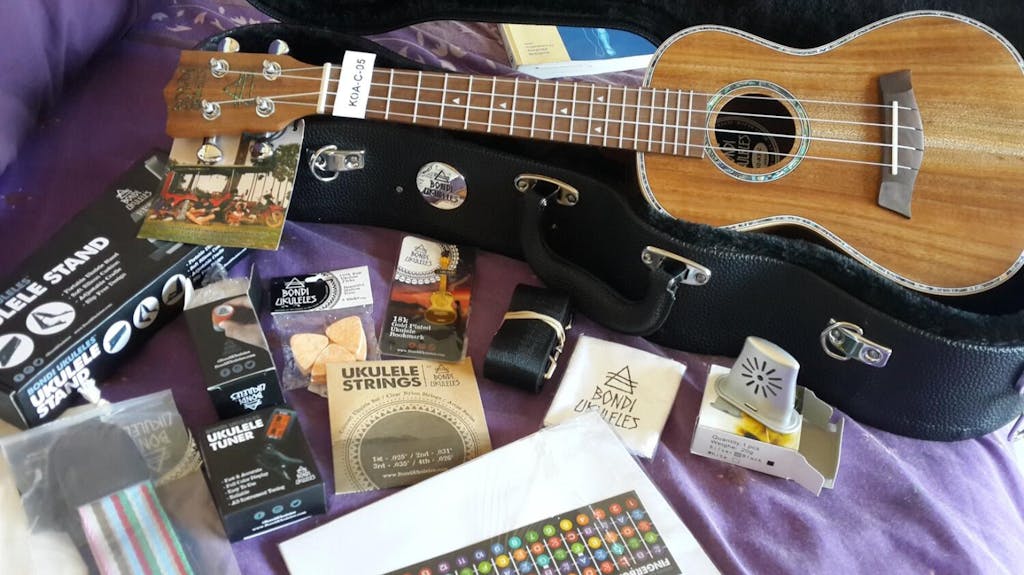Why Koa Ukuleles Are the Heart of Hawaiian Sound

If you’ve ever copped an earful of the warm, rich strumming from a true-blue Hawaiian ukulele, there’s a fair chance it was crafted from koa wood. Known for its ripper tone, striking good looks, and deep cultural roots, the koa ukulele isn’t just another instrument — it’s a proper icon of the islands.
In this article, we’ll explore the history of koa wood, its unique tonal characteristics, and why it continues to be the premium choice for ukulele lovers around the world.
A Brief History of Koa Wood and the Ukulele
The word “koa” means bold or brave in Hawaiian, and this native hardwood lives up to its name. Found only in Hawaii, Acacia koa grows on the slopes of the islands’ volcanic mountains. It has been used for centuries by Native Hawaiians to make canoes, surfboards, weapons, and musical instruments.
When Portuguese immigrants introduced the ukulele to Hawaii in the late 1800s, local luthiers began crafting them using koa wood. Its abundance, workability, and stunning grain patterns made it a natural choice. Over time, the koa ukulele became the gold standard, deeply intertwined with Hawaiian music and identity.
Even today, a traditional Hawaiian ukulele made from koa is considered the most authentic — both in sound and spirit.

The Tone of Koa: Balanced, Warm, and Bright
One of the biggest reasons musicians love koa is its distinct tonal profile. It offers a beautiful balance of brightness, warmth, and projection.
Tonal Qualities of Koa Ukulele:
-
Midrange Focus: Koa produces a sweet, rounded midrange that suits both strumming and fingerpicking.
-
Bright Top End: Fresh koa ukuleles often sound crisp and articulate, especially when new.
-
Aging Gracefully: Like fine wine, koa ukuleles “open up” over time. As the wood matures, the sound becomes warmer and more resonant.
-
Responsive Dynamics: Whether you're lightly picking or strumming hard, koa offers rich tonal feedback.
Koa's tonal versatility makes it a favorite for players who want an instrument that sounds just as beautiful as it looks.
Why Koa Ukuleles Are Considered Premium
So what makes a koa ukulele premium? Here are the top reasons:
1. Limited Availability
Koa only grows in Hawaii, and harvesting is strictly regulated to protect native forests. This limited supply contributes to its exclusivity and price.
2. Stunning Aesthetics
No two pieces of koa are alike. It features dramatic grain patterns — including curls, flames, and stripes — with hues ranging from golden brown to reddish amber. High-end models often use curly koa, prized for its 3D shimmering effect.
3. Build Quality
Most koa ukuleles are made by expert luthiers and established brands who specialize in solid wood craftsmanship, ensuring better sound and longer life.
4. Cultural Significance
Owning a koa ukulele is like owning a piece of Hawaiian heritage. It’s a nod to the islands' rich history, skilled craftsmanship, and vibrant musical tradition.
5. High Resale Value
Due to their rarity and demand, koa ukuleles retain their value well and are often considered investment instruments.
Solid Koa vs Laminate Koa: What’s the Difference?
When shopping for a koa ukulele, you’ll come across two main types:
-
Solid Koa Ukulele: Made entirely from koa wood (top, back, and sides). Offers the best tone, resonance, and longevity. These are usually higher-priced.
-
Laminate Koa Ukulele: Uses a thin layer of koa veneer over other tonewoods. While more affordable, it won’t deliver the same tonal depth.
Pro Tip: If you want that signature koa tone and beauty, opt for a solid top koa ukulele at minimum. It's a great middle ground between affordability and sound quality.
Who Should Buy a Koa Ukulele?
Whether you’re a beginner or a seasoned player, a koa ukulele can be a rewarding choice, especially if you value:
-
Authentic Hawaiian sound
-
Stunning wood aesthetics
-
A premium playing experience
-
Long-term investment value
However, if you’re on a tighter budget or prefer a darker, bass-heavy tone, you might explore mahogany or cedar alternatives first.
Where to Find the Best Koa Ukuleles
At Ukulelemate, we stock a handpicked selection of high-quality koa ukuleles from leading brands like:
-
Bondi Ukuleles – Known for solid top koa models that offer excellent value and craftsmanship.
-
Kala – Hawaiian-made models with master-grade koa wood and beautiful finishes.
-
aNueNue – For those seeking a gorgeous, high-end instrument in both tone and design, the aNueNue Koa Ukulele is the perfect choice for you.
A professional luthier sets up every uke we sell to ensure optimal playability — so you can enjoy that signature koa tone right out of the box.

Frequently Asked Questions
Is koa the best wood for ukulele?
It depends on what you’re looking for. Koa is often considered the best for its tonal balance and Hawaiian heritage, but “best” is subjective. Beginners may prefer mahogany for its affordability and warm tone.
Do koa ukuleles get better with age?
Yes! Solid koa ukuleles improve over time as the wood ages and resonates more freely, resulting in a richer, warmer sound.
Why are koa ukuleles more expensive?
Due to koa’s rarity, limited availability, and the handcrafted nature of these instruments, they tend to be priced higher than ukuleles made with more common woods.
Final Thoughts: The Soul of the Islands in Every Strum
A koa ukulele isn’t just an instrument — it’s a legacy. From its rich cultural roots to its shimmering tone and eye-catching beauty, it embodies the soul of Hawaiian music.
Whether you're playing on the beach, recording in a studio, or strumming in your living room, a koa ukulele brings a piece of paradise to your fingertips.
Ready to find yours?
Browse our premium koa ukuleles now
 Lifetime Warranty
Lifetime Warranty  60 Day Returns Policy
60 Day Returns Policy 1-2 Day Delivery
1-2 Day Delivery 






























Leave a comment